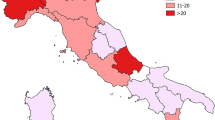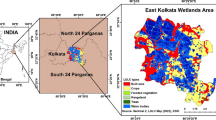Abstract
Losses resulting from winter storms contribute a significant part to the overall losses among all natural hazards in most mid-latitude European countries. A realistic assessment of storm risk is therefore essential for prevention and coping measures. The paper presents a framework for probabilistic storm risk assessment for residential buildings which is exemplarily performed for Germany. Two different approaches are described, and results are presented. The hazard-based approach brings together hazard, vulnerability and building assets to calculate risk curves for each community. The storm-based approach uses loss information from past storm events to calculate statistical return periods of severe storms. As a result, a return period of 83 years to the most severe storm series in 1990 is calculated. Average annual losses of €170 million to residential buildings are calculated for all over Germany. The study demonstrates how the approaches complement each other and how validation is performed.









Similar content being viewed by others
References
Bresch D, Bisping M, Lemcke G (2000) Storm over Europe: an underestimated risk. Swiss Reinsurance Company, Zurich
Efron B, Tibshirani R (1993) An introduction to the bootstrap. Chapman and Hall, New York
GDV (2009) Yearbook 2009, Gesamtverband der Deutschen Versicherungswirtschaft e.V. (GDV), Berlin, 144 pp
Grünthal G, Thieken AH, Schwarz J, Radtke S, Smolka A, Merz B (2006) Comparative risk assessments for the city of Cologne–storms, floods, earthquakes. Nat Hazards 38:21–44
Heneka P (2007) Winter storm damage—risk of residential buildings in the German state of Baden-Württemberg, PhD thesis (in German), Universitätsverlag Karlsruhe, Karlsruhe
Heneka P, Ruck B (2008) A damage model for the assessment of winter storm damage to buildings. Eng Struct 30(12):3603–3609
Heneka P, Hofherr T, Ruck B, Kottmeier C (2006) Winter storm risk of residential structures–model development and application to the German state of Baden-Württemberg. Nat Hazard Earth Sys 6:721–733
Hofherr T, Kunz M (2010) Extreme wind climatology of winter storms in Germany. Clim Res 41:105–123
Huang Z, Rosowsky D, Sparks P (2001) Long-term hurricane risk assessment and expected damage to residential structures. Reliab Eng Syst Saf 74:239–249
Klawa M, Ulbrich U (2003) A model for the estimation of storm losses and the identification of severe winter storms in Germany. Nat Hazard Earth Syst 3:725–732
Kleist L, Thieken A, Köhler P, Müller M, Seifert I, Borst D, Werner U (2006) Estimation of the regional stock of residential buildings as a basis for a comparative risk assessment in Germany. Nat Hazard Earth Syst 6:541–552
Leckebusch GC, Ulbrich U, Fröhlich L, Pinto JG (2007) Property loss potentials for European midlatitude storms in a changing climate. Geophys Res Lett 34:L05703 (4 pp)
Leicester R, Bubb C, Dorman C, Beresford F (1979) An assessment of potential cyclone damage to dwellings in Australia. In: Cermak J (ed) Proceedings of the fifth international conference on wind engineering, vol 1, pp 23–36
Munich Re (2002) Winter storms in Europe (II). Analysis of 1999 losses and loss potentials, Münchener Rückversicherungs-Gesellschaft, München
Munich Re (2007) Zwischen Hoch und Tief—Wetterrisiken in Europa, Münchener Rückversicherungs-Gesellschaft, München
Palutikof JP, Brabson BB, Lister DH, Adcock ST (1999) A review of methods to calculate extreme wind speeds. Meteorol Appl 6:119–132
Petak W, Atkisson A (1982) Natural hazard risk assessment and public policy. Springer, USA
Simmons AJ, Gibson JK (2000) The ERA-40 Project plan. ECMWF report series 1: reading
Steward M (2003) Cyclone damage and temporal changes to building vulnerability and economic risks for residential constructions. J Wind Eng Ind Aerodyn 91:671–691
Thieken AH, Müller M, Kleist L, Seifert I, Borst D, Werner U (2006) Regionalisation of asset values for risk analyses. Nat Hazards Earth Syst Sci 6:167–178
Tyagunov S, Grünthal G, Wahlström R, Stempniewski L, Zschau J (2006) Seismic risk mapping for Germany. Nat Hazard Earth Syst Sci 6:573–586
Uppala SM, Kålberg PW, Simmons AJ, Andrae U, da Costa Bechtold V, Fiorino M, Gibson JK, Haseler J, Hernandez A, Kelly GA, Li X, Onogi K, Saarinen S, Sokka N, Allan RP, Anderson E, Arpe K, Balmaseda MA, Beljaars ACM, van den Berg L, Bidlot J, Borman N, Caires S, Dethof A, Dragosavac M, Fisher M, Fuentes M, Hagemann S, Hólm E, Hoskins BJ, Isaksen L, Janssen PAEM, Jenne R, McNally AP, Mahfouf J-F, Mocrette J-J, Rayner NA, Saunders RW, Simon P, Sterl A, Trenberth KE, Untch A, Vasiljevic D, Viterbo P, Woollen J (2005) The ERA-40 re-analysis. Q J R Meteorol Soc 131:2961–3012. doi:10.1256/qj.04.176
Acknowledgments
This work is part of the Center for Disaster Management and Risk Reduction Technology (http://www.cedim.de), a joint venture of the German Research Center for Geosciences in Potsdam (GFZ), the University of Karlsruhe (TH) and Forschungszentrum Karlsruhe (FZK). We thank the institutions for financial support.
Author information
Authors and Affiliations
Corresponding author
Rights and permissions
About this article
Cite this article
Heneka, P., Hofherr, T. Probabilistic winter storm risk assessment for residential buildings in Germany. Nat Hazards 56, 815–831 (2011). https://doi.org/10.1007/s11069-010-9593-7
Received:
Accepted:
Published:
Issue Date:
DOI: https://doi.org/10.1007/s11069-010-9593-7




